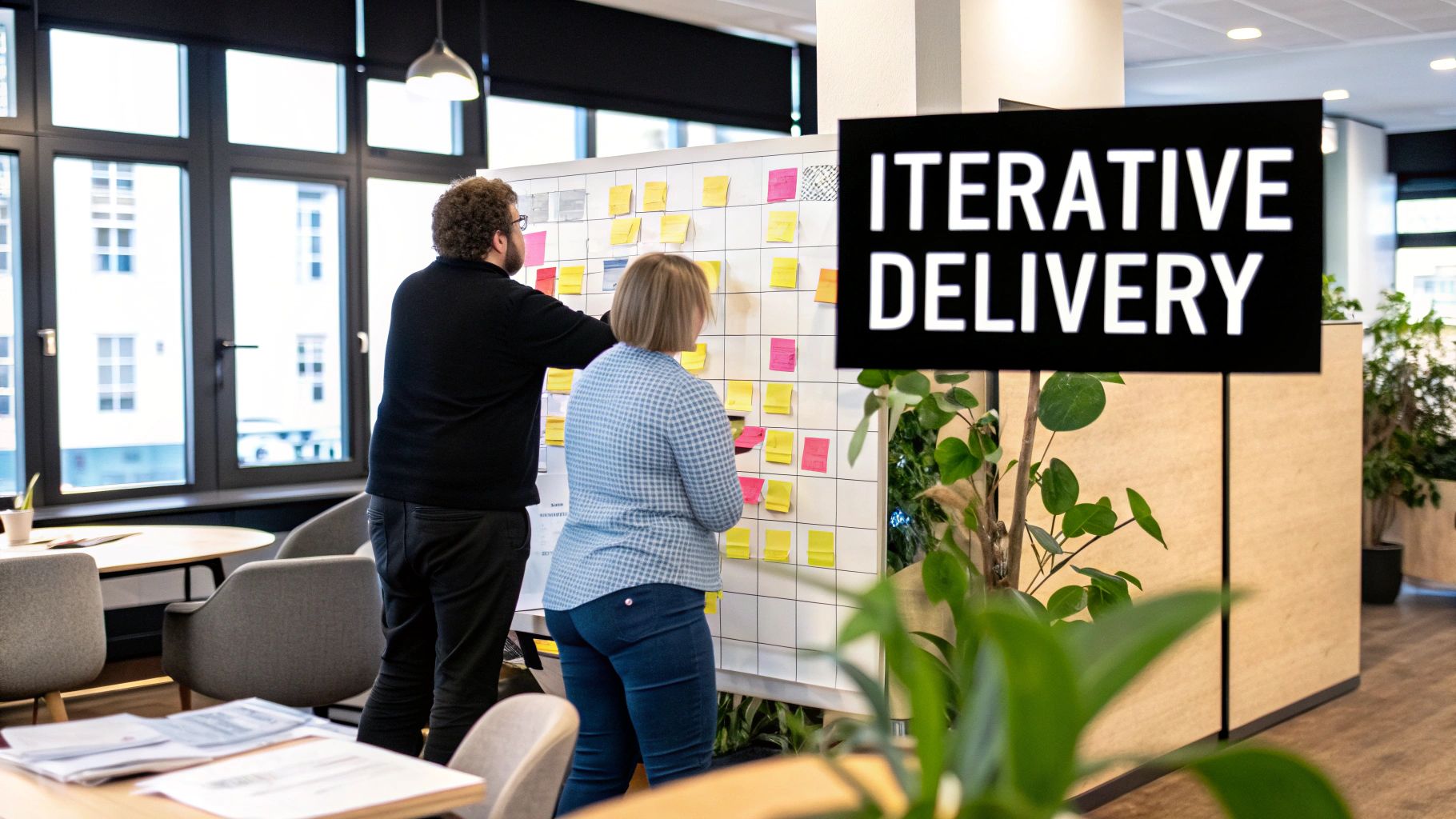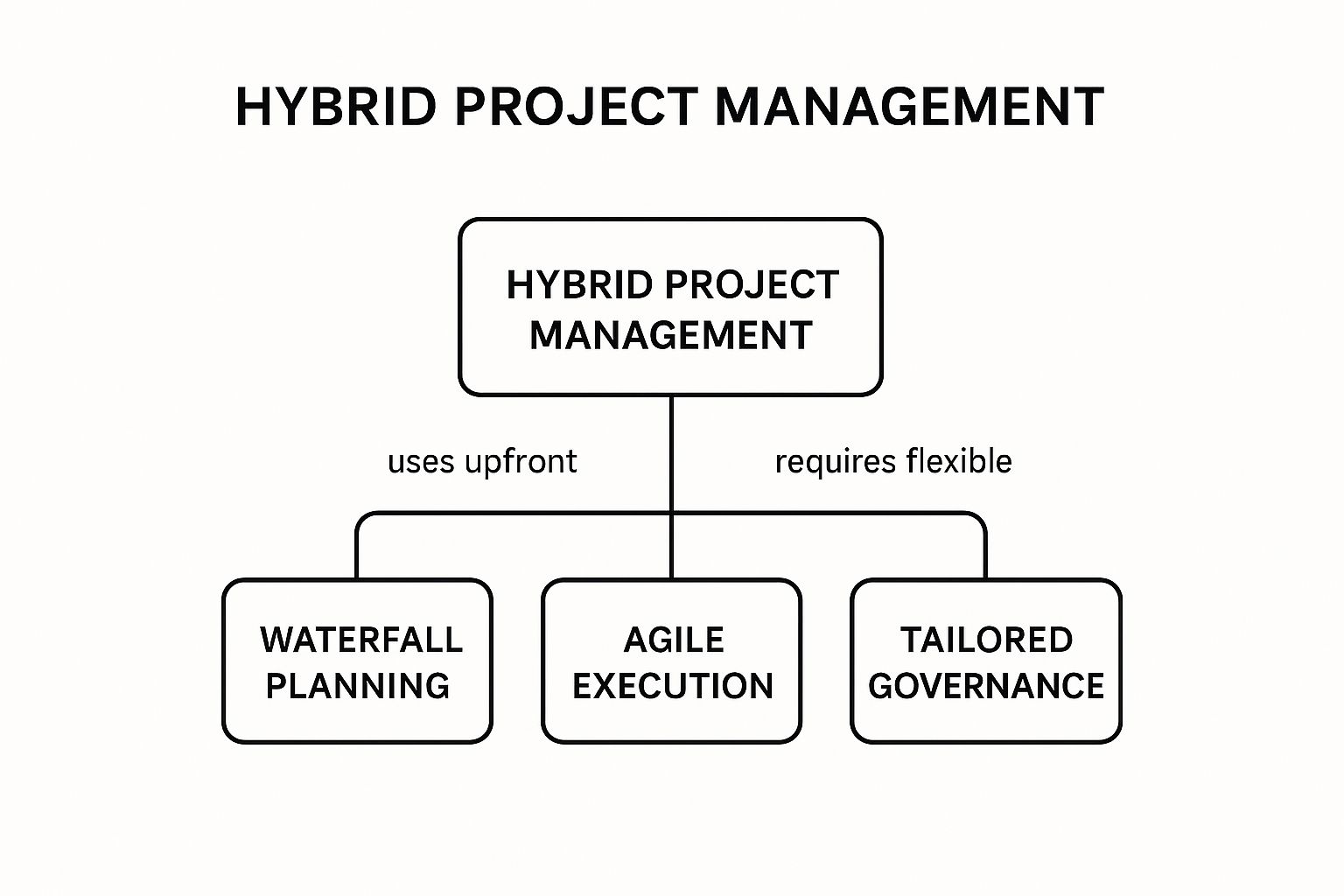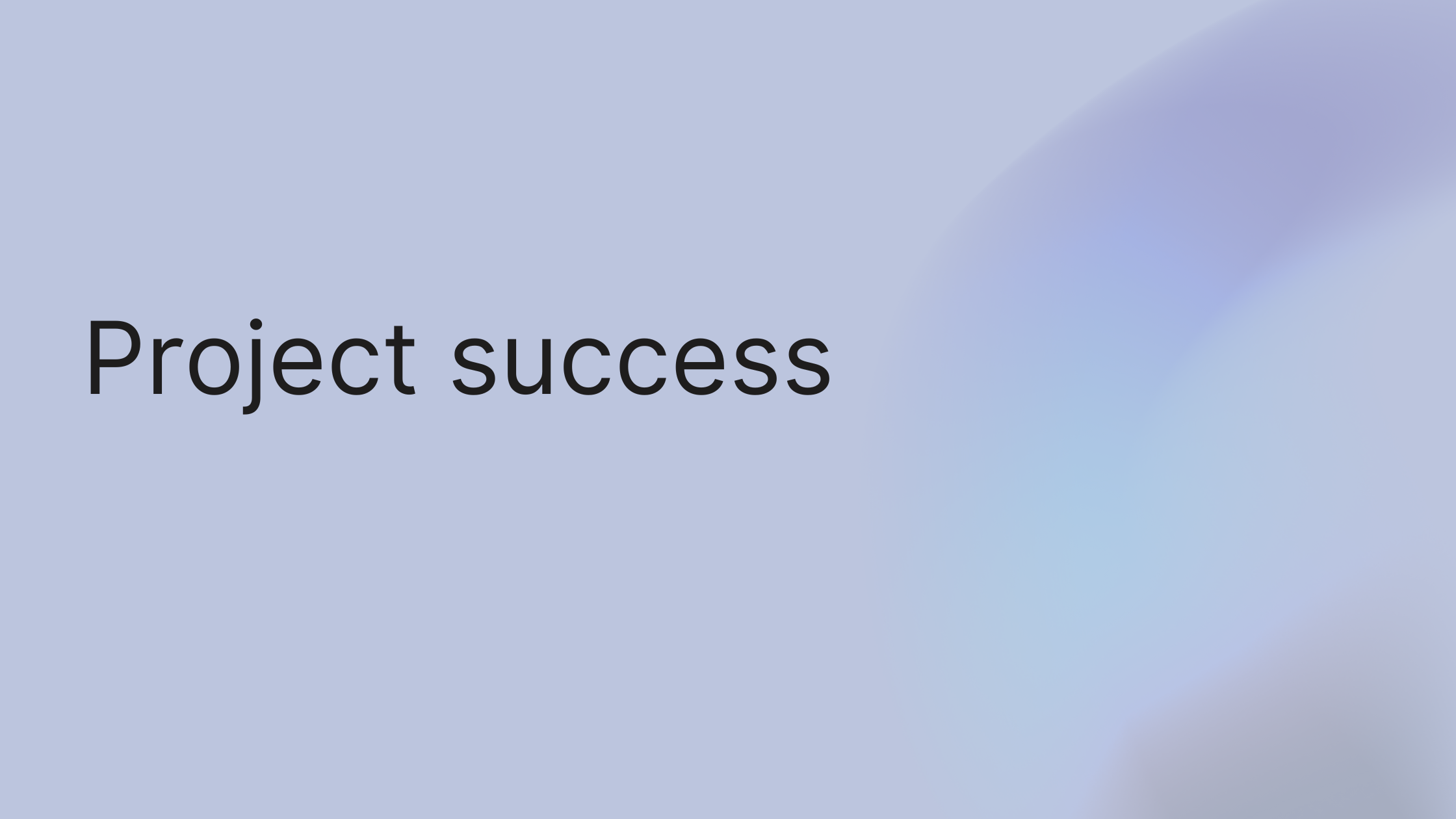Ever feel like your projects are constantly one step away from chaos, derailed by scope creep, missed deadlines, and creeping budgets? That feeling of juggling too many variables is a common pain point for teams everywhere. The good news? You can regain control today. The quick win: Pick one active project and simply map its tasks on a "To Do," "In Progress," and "Done" board. This single act of visualization is your first step toward clarity and a core principle of many powerful strategies.
This guide provides a practical, step-by-step toolkit for implementing ten powerful strategies in project management. We'll break down the core principles of methodologies like Agile, Waterfall, Scrum, and the Critical Path Method, giving you actionable steps to implement them immediately. You'll learn how to identify which strategy best fits your team’s workflow, client demands, and project complexity. More than just a list, this is designed to help you deliver projects on time and on budget, consistently.
By understanding these frameworks, you also build a foundation for continuous improvement. Beyond specific project methodologies, understanding and implementing effective organizational learning strategies are crucial for long-term success and adaptability. Let's explore the systems that will help you regain control and drive predictable, successful outcomes.
1. Agile Project Management
Feeling trapped by rigid plans that can't adapt to unexpected client feedback or market shifts? A quick win is to break your next project into a single, two-week "sprint" and focus solely on delivering one valuable, working feature by the end of it. This small change introduces the core rhythm of Agile.
Agile is an iterative approach that values flexibility, collaboration, and rapid adaptation. Instead of one long development cycle, projects are broken into short increments, typically lasting one to four weeks. This framework allows teams to deliver working software or project components frequently, gather real-time feedback, and adjust priorities on the fly. It's one of the most effective strategies in project management for dynamic environments where requirements are likely to evolve.

Actionable Steps for Implementation
To implement Agile:
- Step 1: Define Sprints: Break your project timeline into fixed-length sprints. A two-week sprint is a common starting point.
- Step 2: Establish a Backlog: Create a prioritized list of all tasks and features. The team will pull work from this backlog for each sprint.
- Step 3: Hold Daily Stand-ups: Conduct short, daily meetings (around 15 minutes) where each team member shares progress, plans, and any obstacles.
Inside growlio, you can easily manage your sprints using custom task boards. Create columns for "Backlog," "In Progress," "Review," and "Done" to visualize your workflow and track progress transparently.
Pro tip: Establish a clear "Definition of Done" (DoD). This is a checklist of criteria that a task must meet to be considered complete. A strong DoD prevents ambiguity and ensures consistent quality, covering everything from coding standards to stakeholder approval.
2. Waterfall Project Management
Struggling with projects where scope creep and unclear requirements derail your budget and timeline? A quick win is to dedicate the first phase of your next project entirely to gathering and signing off on all requirements before any design or development work begins. This simple gate establishes the core principle of Waterfall.
Waterfall is a traditional, linear approach where a project cascades sequentially through distinct phases: requirements, design, implementation, testing, and deployment. Each phase must be fully completed and approved before the next can start. This structured methodology emphasizes thorough upfront planning and documentation, making it one of the best strategies in project management for projects with stable requirements and a clearly defined end product.

Actionable Steps for Implementation
To implement Waterfall:
- Step 1: Gather All Requirements: Dedicate the initial phase to defining and documenting every project requirement. Get formal stakeholder sign-off before proceeding.
- Step 2: Create a Detailed Project Plan: Map out each sequential phase with clear timelines, dependencies, and deliverables.
- Step 3: Establish Phase Gates: Set up formal review and approval points between each phase. The project cannot move forward until all criteria for the current phase are met.
In growlio, you can use task dependencies to create a perfect Waterfall plan. Link tasks sequentially so the next task cannot start until the previous one is marked complete, ensuring your project flows exactly as planned.
Pro tip: Implement a strict change control process. Any requested changes after the initial requirements phase should go through a formal review to assess their impact on scope, cost, and timeline. This prevents scope creep and keeps the project on track.
3. Critical Path Method (CPM)
Worried that one small delay could derail your entire project timeline? A quick win is to map out all your project tasks and their dependencies, then identify the longest chain of tasks. This sequence is your critical path, and protecting it becomes your top priority.
The Critical Path Method (CPM) is a powerful technique for scheduling and managing project timelines. It involves identifying the longest sequence of dependent tasks, known as the "critical path," which determines the minimum time needed to complete the project. Any delay on this path directly delays the project's completion, making it one of the most vital strategies in project management for complex, time-sensitive initiatives.
Actionable Steps for Implementation
To implement CPM:
- Step 1: List All Activities: Break down your project into a detailed list of all required tasks.
- Step 2: Identify Dependencies: Determine which tasks must be completed before others can begin.
- Step 3: Diagram the Network: Create a flowchart or diagram that visualizes the sequence of tasks and their dependencies. This will reveal the critical path.
With growlio, you can use task dependencies to automatically build your project's critical path. Simply link tasks together, and our timeline view will highlight the sequence of tasks that drives your project's completion date.
Pro tip: Use three-point estimation (optimistic, pessimistic, and most likely) to determine the duration of each task. This provides a more realistic and risk-adjusted timeline compared to a single, best-guess estimate, making your critical path analysis much more accurate.
4. Scrum Framework
Struggling with projects that lose momentum or focus over long periods? A powerful quick win is to dedicate your next team meeting to defining just three roles: a Product Owner (the decision-maker), a Scrum Master (the facilitator), and the Development Team (the doers). This simple act of defining roles introduces the core structure of Scrum.
Scrum is an Agile framework that organizes work into fixed-length iterations called sprints, typically two to four weeks long. It provides a prescriptive approach with specific roles, events, and artifacts to manage complex product development. This structured yet flexible system helps teams deliver value incrementally and adapt to changes, making it one of the most popular strategies in project management for building complex products.
Actionable Steps for Implementation
To implement Scrum:
- Step 1: Establish Key Roles: Designate a Product Owner to manage the backlog, a Scrum Master to guide the process, and a Development Team to execute the work.
- Step 2: Run a Sprint Planning Meeting: Before each sprint, hold a meeting where the team selects a chunk of work from the product backlog to complete during the upcoming sprint.
- Step 3: Hold a Sprint Retrospective: After each sprint, facilitate a meeting for the team to reflect on what went well, what didn't, and what can be improved for the next sprint.
With growlio, you can build and manage your Product Backlog and Sprint Backlogs with ease. Use our customizable boards to create a visual representation of your Scrum workflow, assign roles, and track tasks from sprint planning to completion.
Pro tip: Maintain a well-groomed Product Backlog. The Product Owner should regularly review, prioritize, and refine backlog items to ensure they are clear, relevant, and ready for future sprints. A healthy backlog is the foundation of effective sprint planning.
5. PRINCE2 (Projects IN Controlled Environments)
Is your project spiraling out of control with unclear roles, a weak business case, and a lack of stage-by-stage oversight? A quick win is to define clear "tolerances" for your project's scope, timeline, and budget. If any of these are at risk of being breached, the issue is immediately escalated, introducing the core PRINCE2 principle of "management by exception."
PRINCE2 is a structured, process-based methodology that emphasizes control, justification, and a defined organizational structure. It divides projects into manageable and controllable stages, ensuring the business case is reviewed and remains valid at every step. This framework is one of the most robust strategies in project management for large-scale, high-risk initiatives where governance and accountability are paramount.
Actionable Steps for Implementation
To implement PRINCE2:
- Step 1: Establish a Project Board: Define clear roles and responsibilities for the Executive, Senior User, and Senior Supplier who will oversee the project.
- Step 2: Create a Business Case: Develop a detailed document outlining the project's justification, benefits, and risks. This document is reviewed at the end of each stage.
- Step 3: Plan in Stages: Divide the project into distinct management stages. At the end of each stage, the project board decides whether to proceed to the next.
With growlio, you can structure your PRINCE2 stages using project templates. Set up milestones for each stage gate review and use task dependencies to ensure the business case is approved before the next stage's tasks can begin.
Pro tip: Focus on tailoring PRINCE2 to your project's specific needs. A common mistake is applying the entire methodology rigidly to a small project. Instead, scale the processes and documentation to match the complexity and risk involved, ensuring the framework serves the project, not the other way around.
6. Lean Project Management
Are your project timelines bloated with unnecessary meetings, rework, and delays? A quick win is to identify one recurring, time-consuming task that doesn't directly add value for the client, such as a redundant approval step, and eliminate it for your next project. This small act of cutting waste is the essence of Lean thinking.
Lean Project Management adapts principles from manufacturing to focus on maximizing customer value by relentlessly eliminating waste. The core idea is to deliver more with less, trimming any activity, process, or feature that doesn't contribute to the final product. This is one of the most powerful strategies in project management for creating efficient, value-driven workflows and improving profitability.
Actionable Steps for Implementation
To implement Lean:
- Step 1: Identify Value: Clearly define what the customer values. Any step that doesn't contribute to this is considered waste.
- Step 2: Map the Value Stream: Visualize your entire workflow from start to finish to identify bottlenecks, delays, and non-value-adding activities.
- Step 3: Eliminate Waste: Systematically remove the "seven wastes" of Lean, including defects, overproduction, waiting, and unnecessary motion.
With growlio, you can set up a Kanban board in minutes. Use columns like "To Do," "In Progress," and "Done" and set WIP limits on your "In Progress" column to enforce a smooth, efficient flow and stop starting new work before finishing existing tasks.
Pro tip: Use a Kanban board as a visual management tool. It helps you see the flow of work, limit work-in-progress (WIP), and expose bottlenecks in real-time. Limiting WIP is a core Lean principle that prevents team burnout and improves focus.
7. Kanban Method
Is your team constantly starting new tasks before finishing old ones, leading to bottlenecks and missed deadlines? A quick win is to visualize your current workflow on a simple board with three columns: "To Do," "Doing," and "Done." Limit the "Doing" column to just two or three items to immediately see how focusing on less work at once improves flow.
Kanban is a visual workflow management method that emphasizes continuous delivery and process improvement. Originating from Toyota's manufacturing system, it uses boards and cards to represent work items as they move through various stages. Unlike time-boxed methods like Scrum, Kanban focuses on limiting Work-In-Progress (WIP) to optimize flow, making it one of the most powerful strategies in project management for teams that need to manage a continuous stream of tasks with varying priorities.

Real-World Use Case: Zara's Agile Fashion Cycle
Fast-fashion giant Zara uses Kanban principles to manage its entire supply chain, from design concept to store delivery. By visualizing the workflow on a massive board, they can track each clothing line, identify production bottlenecks instantly, and manage dependencies between design, manufacturing, and logistics. This allows them to react to new fashion trends and get products to market in weeks, far outpacing traditional retailers who operate on seasonal cycles.
Actionable Steps for Implementation
To implement Kanban:
- Step 1: Visualize Your Workflow: Map out your current process steps as columns on a board. Start simple with "To Do," "In Progress," and "Done."
- Step 2: Limit Work-In-Progress (WIP): Set explicit limits for how many tasks can be in each "in-progress" column at one time. This is the core of Kanban.
- Step 3: Manage Flow: Focus on moving cards smoothly from left to right. When a task is completed, the team pulls the next highest-priority task into the now-vacant slot.
With growlio, you can create a fully customizable Kanban board in seconds. Set WIP limits for columns to prevent team overload, use color-coded cards to categorize tasks, and get an instant visual overview of your entire project pipeline.
Pro tip: Don't get stuck with a static board. Regularly review your workflow and ask the team, "Where are the bottlenecks?" Use this feedback to adjust your columns and WIP limits. For example, you might split "In Progress" into "Development" and "Review" to better manage your process.
8. Six Sigma Project Management
Struggling with inconsistent project outcomes and customer complaints about quality? A quick win is to map out one of your recurring internal processes, like client onboarding, and identify a single, measurable defect to eliminate. This small, data-driven focus introduces the core principle of Six Sigma.
Six Sigma is a highly disciplined, data-driven methodology that aims for near-perfection by eliminating defects and reducing process variation. It uses statistical methods and structured frameworks like DMAIC (Define, Measure, Analyze, Improve, Control) to solve problems. This makes it one of the most powerful strategies in project management for organizations that prioritize quality, efficiency, and measurable results.
Actionable Steps for Implementation
To implement Six Sigma:
- Step 1: Define the Problem: Clearly identify a problem, its business impact, and the customer requirements. What does a "defect" look like?
- Step 2: Measure Performance: Collect data to measure the current process performance and establish a baseline.
- Step 3: Analyze the Root Cause: Use statistical analysis to find the root causes of defects and process inefficiencies.
With growlio, you can create custom fields to track key metrics like defect rates or cycle times directly within your project tasks. This helps your team gather the crucial data needed for the Measure and Analyze phases of DMAIC.
Pro tip: Focus on the "Voice of the Customer" (VOC) from the very beginning. All process improvements should be directly linked to what the customer values. This ensures your efforts don't just optimize a process but also deliver tangible value and increase satisfaction.
9. Critical Chain Project Management (CCPM)
Are your projects constantly delayed because one overloaded team member becomes a bottleneck for everyone else? For your next project, try identifying the single most constrained resource (a person or a machine) and build the entire schedule around protecting their time, adding a "project buffer" at the end instead of padding individual tasks. This is the core principle behind CCPM.
Critical Chain Project Management (CCPM) shifts focus from task deadlines to resource availability. Developed from the Theory of Constraints, it identifies the longest sequence of resource-dependent tasks (the "critical chain") and adds buffers to protect the project's completion date from uncertainty. This is one of the most powerful strategies in project management for resource-constrained environments, as it prioritizes finishing the entire project faster over meeting individual task deadlines.
Actionable Steps for Implementation
To implement CCPM:
- Step 1: Identify the Critical Chain: Map out your project tasks and identify the longest chain based on both task dependencies and resource constraints.
- Step 2: Remove Task Padding: Estimate task durations aggressively, removing the "safety time" individual team members usually add. For more on this, you can explore various project estimation techniques on growlio.io.
- Step 3: Add Project Buffers: Place time buffers at the end of the critical chain to absorb delays from any task along the chain, protecting the final delivery date.
With growlio, you can use resource management views to identify over-allocated team members who might represent your critical chain. Assigning tasks and visualizing workloads helps ensure your most vital resources are protected.
Pro tip: Promote a "relay race" mentality for handoffs. Once a team member finishes their task, they should immediately hand it off to the next person in the chain, rather than starting a new, unrelated task. This focus eliminates harmful multitasking and keeps the critical chain moving.
10. Hybrid Project Management
Struggling to choose between the structured planning of Waterfall and the flexibility of Agile? For your next project, try planning your high-level milestones and budget using a traditional approach but execute the actual development or creative work in two-week Agile sprints. This gives you the best of both worlds: predictability for stakeholders and adaptability for your team.
Hybrid project management is a flexible approach that strategically combines elements from different methodologies to fit a project's unique needs. It blends the upfront planning and documentation of traditional methods like Waterfall with the iterative execution and feedback loops of Agile. This makes it one of the most powerful strategies in project management for complex projects that require both long-term predictability and short-term agility.
This concept map illustrates how Hybrid Project Management integrates different frameworks into a cohesive strategy.

The visualization shows that a successful hybrid model depends on balancing structured, long-term planning with flexible, iterative execution, all guided by a governance framework adapted to this blended approach.
Actionable Steps for Implementation
To implement a Hybrid approach:
- Step 1: Define the Divide: Clearly determine which project phases will follow which methodology. For instance, use Waterfall for requirements gathering and budget approval, then switch to Agile for development and testing.
- Step 2: Establish Communication Protocols: Ensure seamless handoffs and communication between phases. A team finishing a Waterfall planning stage must effectively transfer information to the team starting an Agile execution sprint.
- Step 3: Train the Team: Make sure everyone understands the principles of both methodologies being used and their specific role within the hybrid framework.
With growlio, you can easily support a hybrid model. Use a timeline view for your high-level Waterfall planning and then switch to custom task boards to manage your Agile sprints, all within the same project. Learn more about Hybrid Project Management on growlio.io.
Pro tip: Create a "Hybrid Playbook" for your organization. This document should outline when to use a hybrid model, which specific elements to combine, and the rules of engagement. This prevents confusion and ensures consistency across different projects.
Top 10 Project Management Strategies Compared
| Methodology | Implementation Complexity 🔄 | Resource Requirements ⚡ | Expected Outcomes 📊 | Ideal Use Cases 💡 | Key Advantages ⭐ |
|---|---|---|---|---|---|
| Agile Project Management | Moderate to High; requires trained, experienced teams and customer involvement | Moderate; cross-functional teams, continuous collaboration | Frequent working product increments, high adaptability | Projects needing flexibility, rapid delivery, customer feedback | High flexibility, fast time-to-market, improved collaboration |
| Waterfall Project Management | Low to Moderate; well-defined, sequential phases | Moderate; upfront detailed planning and documentation | Predictable timelines and budgets, complete documentation | Projects with stable requirements and regulatory compliance | Clear structure, predictability, easy to manage |
| Critical Path Method (CPM) | Moderate; involves detailed scheduling and calculations | Moderate; requires accurate time estimates and updates | Optimized schedule, identification of critical tasks | Complex projects needing precise time management | Accurate duration estimates, resource prioritization |
| Scrum Framework | Moderate to High; requires training, cultural change | Moderate; dedicated roles and ceremonies | Regular delivery, enhanced transparency, team focus | Agile projects requiring structured teamwork and rapid iteration | Improved productivity, risk reduction, stakeholder engagement |
| PRINCE2 | High; comprehensive, formal documentation and processes | High; extensive planning, roles, training | Well-controlled projects, clear accountability | Large-scale projects needing formal governance and control | Strong structure, business focus, scalability |
| Lean Project Management | Moderate to High; significant cultural change needed | Moderate; experienced practitioners required | Waste reduction, faster delivery, continuous improvement | Projects aiming to minimize waste and optimize flow | Cost reduction, efficiency, continuous improvement |
| Kanban Method | Low to Moderate; easy to start, requires discipline | Low to Moderate; visual boards, WIP limits | Continuous flow, improved work visibility | Workflows needing flexible, transparent progress tracking | High visibility, adaptability, continuous delivery |
| Six Sigma Project Management | High; data-driven and statistically intensive | High; requires training and software tools | Significant quality improvements, cost savings | Process improvement and quality-critical projects | Structured problem solving, strong ROI, data-driven decisions |
| Critical Chain Project Management (CCPM) | High; requires mindset shift and buffer management | Moderate to High; resource-focused planning | Reduced duration, better resource use | Resource-constrained projects needing schedule control | Improved completion rates, constraint focus |
| Hybrid Project Management | High; combining methodologies increases complexity | High; needs skills across methods | Customized frameworks tailored to project needs | Diverse or complex projects requiring flexibility | Flexibility, leveraging strengths of multiple approaches |
Stop Juggling, Start Delivering
The central takeaway is that there is no single "best" methodology. The most successful project managers don't just pick one strategy and stick to it. Instead, they build a versatile toolkit, understanding the core principles of each approach so they can select, blend, and adapt them to fit the specific needs of a project, client, or team. Mastering these strategies in project management is about moving from a reactive to a proactive state, from simply managing tasks to orchestrating successful outcomes with confidence and precision.
The goal is to spend less time managing your management system and more time delivering exceptional work. By thoughtfully selecting and implementing the right strategies, you create a repeatable system for success, turning project chaos into predictable profitability.
Ready to implement these strategies without the chaos of juggling multiple tools? Stop wrestling with spreadsheets and start delivering projects seamlessly. Start your free growlio account today on growlio.io and see how a unified platform can transform your workflow.
